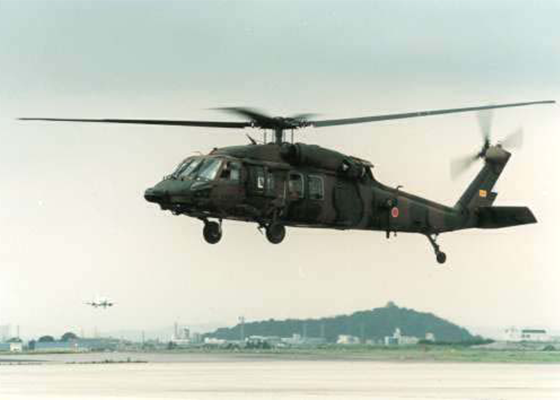Making Best Use Of Effectiveness and Safety And Security With the UH-60 Helicopter

The Adaptability of the UH-60
The UH-60 helicopter shows remarkable adaptability in its array of capabilities and missions. Designed primarily as a medium-lift energy helicopter for the united state Army, the UH-60 has proven itself to be versatile to a variety of tasks. It can work as a troop transportation, lugging as much as 11 combat-loaded soldiers, or as a cargo transport, efficient in lifting an optimum of 9,000 extra pounds on the surface. In addition, the UH-60 can be set up for clinical evacuation missions, with the capacity to fit as much as 6 cots and medical employees.
In regards to its operational capabilities, the UH-60 is equipped with sophisticated avionics and navigating systems, enabling it to do goals in day, night, and damaging climate condition. It has a variety of over 320 nautical miles and an optimum rate of around 185 knots. With its effective engines, the UH-60 can operate at high altitudes and in warm and moist settings, making it suitable for a vast range of geographical areas.

Advanced Safety Attributes
With an emphasis on ensuring maximum safety, the UH-60 helicopter is equipped with a range of sophisticated features. The UH-60 likewise integrates innovative avionics systems, including an electronic flight control system and a thorough flight administration system. Overall, these innovative safety functions of the UH-60 helicopter contribute to its credibility as a dependable and secure airplane for a vast range of missions.
Enhancing Functional Effectiveness

In enhancement to sophisticated avionics, the UH-60 helicopter incorporates reliable engine innovation. The UH-60 helicopter features a durable maintenance program.
Moreover, the UH-60 helicopter is created with an emphasis on comfort designs and straightforward interfaces. Cockpit layouts are instinctive, decreasing the cognitive work on pilots and enhancing their efficiency. In addition, the helicopter's roomy cabin enables simple loading and unloading of employees and cargo, further enhancing operational effectiveness.
Improving Upkeep Processes
In order to further optimize functional efficiency, the UH-60 helicopter concentrates on improving upkeep processes. uh 60. This is vital in guaranteeing that the airplane remains in peak problem and is constantly ready for implementation. By streamlining maintenance procedures, the UH-60 helicopter aims to lessen downtime and increase its accessibility for goals
One method the UH-60 helicopter attains this is through the execution of a computerized maintenance monitoring system (CMMS) This system enables for reliable like it tracking and scheduling of maintenance jobs, making sure that upkeep is done on schedule and in an organized fashion. It likewise assists in managing extra parts supply, lowering the moment required for purchase and lessening the risk of stockouts.
Additionally, the UH-60 helicopter utilizes a condition-based maintenance (CBM) technique. This implies that upkeep actions are performed based on the real problem of the aircraft, instead of on a taken care of routine. By making use of data and sensing units analysis, the UH-60 helicopter can discover potential problems prior to they become important, allowing for positive maintenance and minimizing the risk of unforeseen failings.
Furthermore, the UH-60 helicopter integrates a modular design, which simplifies maintenance and decreases turnaround time. The aircraft's elements are made to be quickly obtainable and changeable, minimizing the need for extensive disassembly and reducing upkeep hours.
The Future of UH-60 Innovation
Improvements in innovation are shaping the future of the UH-60 helicopter, making certain boosted performance and security in its operations. As technology proceeds to progress, so does the UH-60, making it much more capable and reliable than ever.
One location where innovation is making a considerable effect is in the area of avionics. The UH-60 is being outfitted with sophisticated digital displays and interaction systems, supplying pilots with real-time details and enhancing situational awareness. These advancements enable quicker decision-making and even more exact navigating, ultimately improving the safety of the aircraft.
Furthermore, the UH-60 is gaining from improvements in propulsion systems. More recent engines are being created that deal enhanced power and gas effectiveness, permitting longer array and expanded goal abilities. This not only enhances functional effectiveness yet additionally minimizes the environmental effect of the helicopter.
Moreover, improvements in products and producing find techniques are making the UH-60 lighter and much more durable. Compound materials are being utilized in the building of the airframe, lowering weight while keeping structural honesty. This causes enhanced performance, enhanced payload ability, and reduced upkeep demands.
Final Thought
In conclusion, the UH-60 helicopter stands as an amazing airplane with its adaptability, progressed security features, and reliable operational and upkeep processes. Its ability to adapt to numerous missions and surface makes it a beneficial asset for military operations. As innovation remains to advancement, the future of the UH-60 holds even higher capacity for additional enhancements and innovations in both efficiency and safety.
To optimize operational effectiveness, numerous actions are applied in the UH-60 helicopter. The UH-60 helicopter is geared up with cutting edge navigation, communication, and goal systems, permitting for boosted situational recognition and effective control in between staff members.In order to additional optimize functional performance, the UH-60 helicopter focuses on improving maintenance procedures.One means the UH-60 helicopter accomplishes this is with the implementation of a computerized maintenance administration system (CMMS)In final thought, the UH-60 helicopter stands as an exceptional aircraft with its adaptability, advanced safety view publisher site features, and efficient functional and maintenance processes.